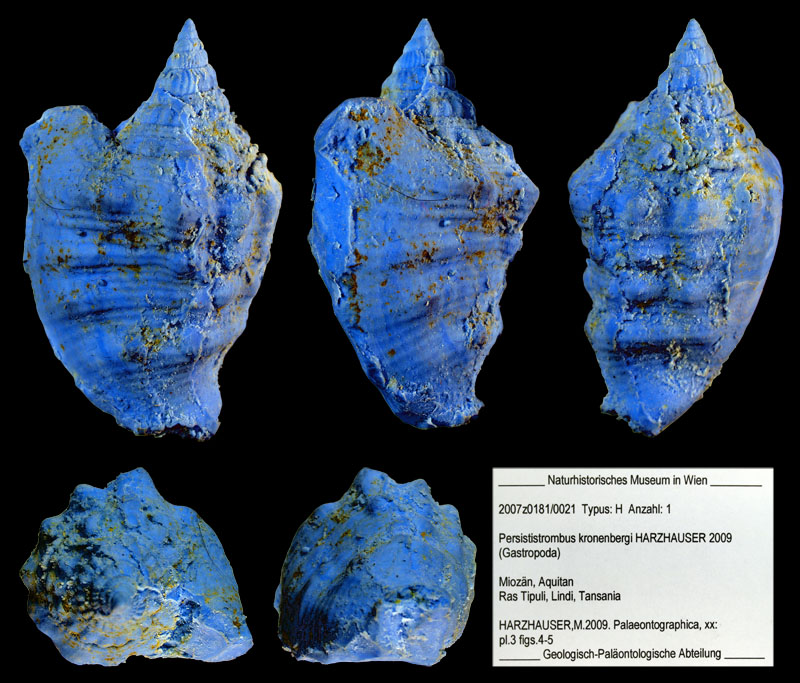Species / Persististrombus Kronenbergi
Stromboidea
Original Diagnosis of Persististrombus kronenbergi by Harzhauser, 2009, p. 137:
- "Small strombid with high spire and a charcteristic change in sculpture from straight axial ribs on early teleoconch whorls to nodes and a cancellate adsutural cord on the penultimate whorl. The last whorl bears 4 rows of nodes and numerous spiral ribs and develops a small wing with free posterior tip."
Original Description of Persististrombus kronenbergi by Harzhauser, 2009, p. 137:
- "Small, stout strombid with tall spire consisting of 4 smooth, high protoconch whorls and 4 spire whorls. The earliest two spire whorls develop a close-set pattern of straight to weakly opisthocline axial ribs separated by narrow interspaces. No spiral sculpture visible except for a faint spiral incision close to the posterior suture. One to two varices may occur on these early whorls. Within the third teleoconch whorl a slight angulation appears along the axial ribs and a narrow spiral cord is developed along the posterior suture. Within the fourth teleoconch whorl, the axial ribs grade into low nodes which are crossed by delicate threads. The adsutural cord becomes broader, grades into a narrow and concave ramp and is sculptured by a cancellate pattern of threads. Some specimens bear a spiral cord of granules along the posterior suture. Spiral threads start to predominate the sculpture of the ramp on the last whorl, where 10-15 axially elongated nodes mark the sharp angulation into the base. Three spiral swellings appear below the angulation; the upper two bear distinct but low nodes, whereas the lowermost (anterior) one lacks well-defined nodes. In addition, the entire shell is covered by spiral ribs which tend to be more prominent along the spiral swellings with nodes. The interspaces and ribs are about equally wide. The siphonal canal is short but strongly twisted. A small wing is developed; its posterior tip reaches up to the penultimate whorl without fusing with the spire whorls."
Locus typicus: Ras Tipuli, Lindi bay, Tanzania
Stratum typicum: bioclastic limestones of the Ras Tipuli Geobreccia, Aquitanian, early Miocene.
Types: Holotype NHMW no. 2007z0181/0021; Paratypes: NHMW nos. 2007z0181/0022 And NHMW 2007z0181/0023
Persististrombus kronenbergi Harzhauser, 2009; Holotype; Ras Tipuli Geobreccia, Aquitanian, early Miocene; Ras Tipuli, Lindi bay, Tanzania; in Harzhauser, 2009, pl. 3, fig, 4, 5; Coll. NHMW no. 2007z0181/0021
References

